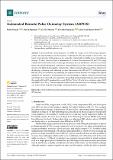Files in this item
Automated Remote Pulse Oximetry System (ARPOS)
Item metadata
| dc.contributor.author | Pirzada, Pireh | |
| dc.contributor.author | Morrison, David | |
| dc.contributor.author | Doherty, Gayle Helane | |
| dc.contributor.author | Dhasmana, Devesh J | |
| dc.contributor.author | Harris-Birtill, David Cameron Christopher | |
| dc.date.accessioned | 2022-07-01T09:30:04Z | |
| dc.date.available | 2022-07-01T09:30:04Z | |
| dc.date.issued | 2022-06-30 | |
| dc.identifier | 280273130 | |
| dc.identifier | 1aac2c84-6b4b-40e5-872b-f469550ddc15 | |
| dc.identifier | 35808469 | |
| dc.identifier | 85133668635 | |
| dc.identifier | 000823951100001 | |
| dc.identifier | 35808469 | |
| dc.identifier.citation | Pirzada , P , Morrison , D , Doherty , G H , Dhasmana , D J & Harris-Birtill , D C C 2022 , ' Automated Remote Pulse Oximetry System (ARPOS) ' , Sensors , vol. 21 , no. 13 , 4974 . https://doi.org/10.3390/s22134974 | en |
| dc.identifier.issn | 1424-8220 | |
| dc.identifier.other | ORCID: /0000-0003-3494-5857/work/115309116 | |
| dc.identifier.other | ORCID: /0000-0002-0740-3668/work/115309465 | |
| dc.identifier.other | PubMedCentral: PMC9269826 | |
| dc.identifier.other | ORCID: /0000-0001-5502-9773/work/136696660 | |
| dc.identifier.uri | https://hdl.handle.net/10023/25597 | |
| dc.description | Funding: This research is funded by the School of Computer Science and by St Leonard’s Postgraduate College Doctoral Scholarship, both at the University of St Andrews for Pireh Pirzada’s PhD. Early work was funded by the Digital Health & Care Innovation Centre (DHI). | en |
| dc.description.abstract | Current methods of measuring heart rate (HR) and oxygen levels (SPO2) require physical contact, are individualised, and for accurate oxygen levels may also require a blood test. No-touch or non-invasive technologies are not currently commercially available for use in healthcare settings. To date, there has been no assessment of a system that measures HR and SPO2 using commercial off-the-shelf camera technology that utilises R, G, B and IR data. Moreover, no formal remote photoplethysmography studies have been done in real life scenarios with participants at home with different demographic characteristics. This novel study addresses all these objectives by developing, optimising, and evaluating a system that measures the HR and SPO2 of 40 participants. HR and SPO2 are determined by measuring the frequencies from different wavelength band regions using FFT and radiometric measurements after pre-processing face regions of interest (forehead, lips, and cheeks) from Colour, IR and Depth data. Detrending, interpolating, hamming, and normalising the signal with FastICA produced the lowest RMSE of 7.8 for HR with the r-correlation value of 0.85 and RMSE 2.3 for SPO2. This novel system could be used in several critical care settings, including in care homes and in hospitals and prompt clinical intervention as required. | |
| dc.format.extent | 44 | |
| dc.format.extent | 11801012 | |
| dc.language.iso | eng | |
| dc.relation.ispartof | Sensors | en |
| dc.rights | Copyright: © 2022 by the authors. Licensee MDPI, Basel, Switzerland. This article is an open access article distributed under the terms and conditions of the Creative Commons Attribution (CC BY) license (https:// creativecommons.org/licenses/by/4.0/). | en |
| dc.subject | Remote health monitoring | en |
| dc.subject | Heart rate measurement | en |
| dc.subject | Blood oxygenation level measurement | en |
| dc.subject | rPPG system | en |
| dc.subject | R Medicine | en |
| dc.subject | QA75 Electronic computers. Computer science | en |
| dc.subject | DAS | en |
| dc.subject | MCC | en |
| dc.subject.lcc | R | en |
| dc.subject.lcc | QA75 | en |
| dc.title | Automated Remote Pulse Oximetry System (ARPOS) | en |
| dc.type | Journal article | en |
| dc.contributor.institution | University of St Andrews.School of Computer Science | en |
| dc.contributor.institution | University of St Andrews.Centre for Biophotonics | en |
| dc.contributor.institution | University of St Andrews.School of Psychology and Neuroscience | en |
| dc.contributor.institution | University of St Andrews.Institute of Behavioural and Neural Sciences | en |
| dc.contributor.institution | University of St Andrews.School of Medicine | en |
| dc.contributor.institution | University of St Andrews.Infection and Global Health Division | en |
| dc.identifier.doi | 10.3390/s22134974 | |
| dc.description.status | Peer reviewed | en |
This item appears in the following Collection(s)
Items in the St Andrews Research Repository are protected by copyright, with all rights reserved, unless otherwise indicated.

